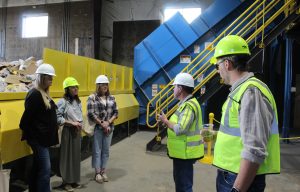‘Tough luck’ – Renewable rules for Steamboat snowmelt systems seen as challenge for developers, energy infrastructure
For the second time in less than two months, the Steamboat Springs City Council adopted an ordinance Tuesday dealing with the city’s energy code.
Council members had adopted a new energy code Oct. 17 that limited commercial snowmelt systems to the base of the mountain and three downtown zoning districts, while placing a size-cap on residential systems at 450 square feet.x
The 6-1 vote in October saw only Dakotah McGinlay voting against the ordinance. But after three new members — all of whom campaigned with an emphasis on sustainability and environmental protection — were sworn in last month, City Council President Gale Gary successfully moved to revisit the matter on Nov. 14.
Part of the city’s larger building code (which is updated every three years), the newly adopted energy rules place tighter restrictions on how commercial and residential snowmelt systems are powered. When the code takes effect Jan. 1, snowmelt systems will be allowed anywhere in the city under the condition that they are powered by renewable energy.
The revised code is based off the 2021 International Energy Code and aligns with the Routt County Action Plan, which aims to reduce countywide greenhouse gas emissions by 35% by 2030, and by 74% by 2050.
Without installing a renewable energy source to power a snowmelt system, developers will need to install electric systems that rely on a Green Choice Program offered by Yampa Valley Electric Association to comply with the new energy codes. The program allows users to pay the energy company for renewable energy credits used to offset the portion of its supply that comes from fossil fuel sources.
Outside of the Green Choice Program supporting an electric system, Routt County Building Official Todd Carr told council members last month that a geothermal power source remains as the only other option for developers who wish to install a snowmelt apparatus.
The cost for a geothermal powered system for the promenade at the base of the mountain is estimated to be roughly $10 million. Public Works Director Jon Snyder has said the new energy code would require design changes for the Gondola Transit Center, which currently includes plans to lay down 120,000 square feet of snowmelt space.
Under the adopted energy code and without a geothermal option, Snyder said last month the city would need to spend between $80,000 and $100,000 to redesign elements of the GTC and push the project back by at least six months.
A partnership with the city and the Steamboat Ski & Resort Corp. requires the city to construct the snowmelt systems, and the resort to maintain them.
The resort has expressed a commitment to renewable energy use but also conveyed concern over the new energy code with respect to how the rules would affect future snowmelt system development, which the resort’s Director of Social Responsibility Sarah Jones said is “critical” to the resort and the safety of its staff and guests.
Jones said the resort would like to see a path to obtain a variance to the new energy rules — and they are not the only developer worried about the impact of the new snowmelt regulations.
On Nov. 14, during the same meeting in which they voted to revisit the energy code ordinance, council members approved plans for a seven-building, 63-unit multi-family residential development near the base of the resort on Ski Trail Lane.
Representing the Astrid Condominiums development group, Melinda Sherman noted the project was expected to begin in the spring of next year. But with the approved plans including gas-powered snowmelt systems and limited time to file a building permit before the new energy codes take effect, she said the project’s progress is now in question.
“The provisions of this new ordinance regarding snowmelt systems threatens to undo all of the applicant’s work to date and could even threaten the viability of the project altogether,” Sherman told council last week, adding that the available utilities on the property are not suitable for the project’s snowmelt plans. “Abruptly changing the course and eliminating the proposed gas-powered snowmelt system at the 11th hour will effectively double the electric service requirements for this project.”
Michael Buccino represented the lone vote against the adoption of the new energy code, and said the concerns raised by the Astrid Condominium group point to a wider impact of the policy change.
“I am still for fossil fuels for some specific uses, but it’s really a challenge because if the city’s infrastructure alone, and Yampa Valley Electric, can’t even provide the right (energy) needed to power this, how do we regulate that?” Buccino said. “How do we force the regulation when now, with our decision on this code, we are going to have to upgrade the entire infrastructure of our entire city to accommodate for future development?”
Gary argued, “snowmelt is a luxury, not mandatory” and said the ordinance shouldn’t be revised based on the impact it would have on a single project.
“This is not forcing them to use electric; they could scale back the amount of snowmelt they have,” Gary said of the Astrid Condominium development. “From my perspective, it’s a policy decision in terms of what the values are in this community in terms of moving forward.”
President Pro-Tem Joella West agreed one development shouldn’t “derail” the energy code adoption, but she noted the consequences of the council’s position with respect to snowmelt regulations.
“(It) may cause us to have things like this happen more than once and we have to be ready for them and we have to deal with them in a reasonable fashion,” West said. “And I think saying ‘tough luck’ is not a reasonable fashion.”
Trevor Ballantyne is the editor for the Steamboat Pilot & Today. To reach him, call 970-871-4254 or email him at tballantyne@SteamboatPilot.com.

Support Local Journalism

Support Local Journalism
Readers around Steamboat and Routt County make the Steamboat Pilot & Today’s work possible. Your financial contribution supports our efforts to deliver quality, locally relevant journalism.
Now more than ever, your support is critical to help us keep our community informed about the evolving coronavirus pandemic and the impact it is having locally. Every contribution, however large or small, will make a difference.
Each donation will be used exclusively for the development and creation of increased news coverage.










